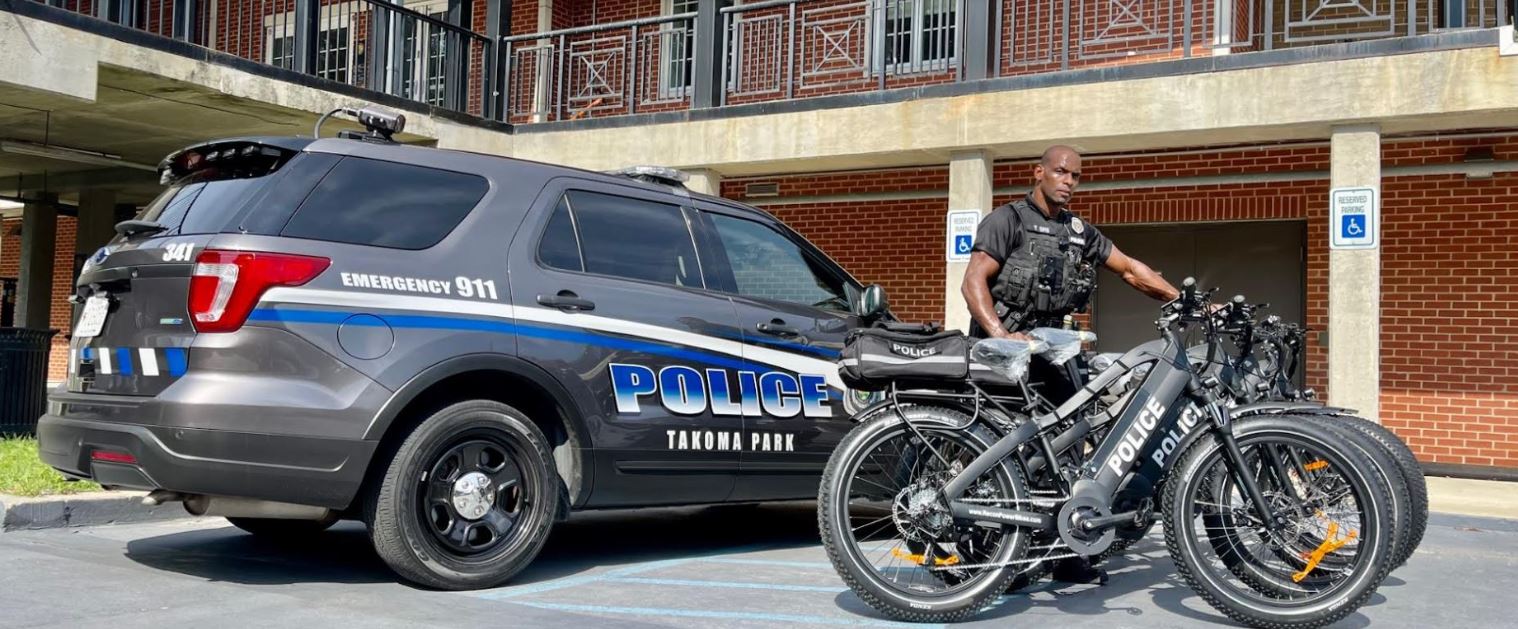Electric Bike Program

What is an Electric Bike?
The State of Maryland defines electric bikes as a bicycle with fully operational pedals, a motor of not more than 750W and a maximum speed of 28 mph on flat surfaces. Electric bike motors must be designed to disengage at 28 mph.
Electric bikes are classified as:
- Class 1: bikes equipped with a pedal-assist only motor which stops when the bike reaches 20 mph
- Class 2: bikes equipped with a motor that may be used exclusively to propel the bicycle and stop when the bike reaches the speed of 20 mph
- Class 3: bikes equipped with a motor that provides assistance only when the rider is pedaling and stops when the rider stops pedaling or when the bicycle reaches the speed of 28 mph.
General Order 659 – Bicycle Patrol
Policy: To utilize bicycle patrols as a supplement to patrol resources and capabilities. Bicycles will be deployed in either residential or commercial areas, or where they can address a specific need. The use and operation of police bicycles is restricted to members of the department who have been properly trained.
Bike patrol officers generally patrol alone when the purpose of the patrol is high visibility, crime prevention and/or the improvement of community relations. When patrolling high crime/drug areas for special enforcement purposes, officers will ride in pairs.
Bike patrol officers will not discharge their firearms while operating a bicycle.
Bicycles will be transported on a rack via patrol vehicle.
When on assignment, the patrol vehicle will be parked near the center of the assigned bicycle patrol area.
When it is necessary to respond to a call while on bike patrol, the officer will use the vehicle if use of the bike is not practical.
The Pros of Electric Bikes
- Bikes are less threatening than patrol vehicles
- Other bicyclists are more accepting of bike patrol officers
- Bike patrols result in more than twice as many contacts with the public than vehicle patrols
- Bike police/security uniforms help officers to quickly transition from their traditional law enforcement duties to more service oriented work
- Perpetrators don’t notice bike patrols
- Bike patrols can go where traditional patrol vehicles can’t go
- Bike officers can use all of their senses to detect illegal activity
- Bikes have other uses: surveillance, community relations through community events
- Bikes cost much less to purchase and maintain than traditional patrol vehicles
- Bikes provide environmental and health benefits. Because bike patrols run on human power rather than gas, their carbon footprint is much smaller than patrol vehicles. With zero emissions and less need for pavement, bike patrols may be an attractive option for communities with green initiatives.
“Electric bikes are a great way for our officers to get out and engage with our residents and businesses. We look forward to expanding our green fleet and connecting with our stakeholders.” – Chief Antonio DeVaul
Benefits of Electric Bikes in Policing
Increase Officer Safety
- Less fatigue upon arrival to calls/less pedaling
- Stealth approach
- Faster back up in dense/high traffic areas
Decrease Response Times
- Ride through traffic
- On sidewalks
- Through alleys
- Through narrow passages
- Within high pedestrian zones
Reduce Injuries
- Less stress on the body
- Easier to ride with all officer safety gear
Enhance Patrol Coverage
- Parking structures
- Off-highway (dirt/back roads)
- Bike paths
- Parking enforcement
- Large events – concerts, parades, parking lots
Takoma Park residents have indicated how much they appreciate seeing officers in their neighborhoods. Police officers on bikes gives them a great opportunity to have that face-to-face relationship with the people in the community; it makes them more approachable. The department has six officers who have completed training to be certified to use the electric bikes.
“The bike unit allows us to go out and have close contact with the public. That’s the main purpose of bike patrol – being able to get closer to the public and it makes us more approachable as police officers. Because, when we’re in our vehicles, people can be more so stand-offish; they don’t really want to approach us. On a bike, we can be more personal and have good contacts with the community.” – Corporal Thomas Sims




